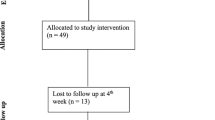Abstract
This project was a program evaluation of an innovative approach to working with adolescent sex offenders at a human service agency in the Intermountain West. A literature review shows little content on the use of yoga and meditation instruction in general, and no content on the use of such methods with adolescent sex offenders. There is evidence, however, that such techniques can contribute to the improved physical and mental health of adults. Adolescent participants, their parents, and their trainers in the program were interviewed. Results of the interviews are summarized, and recommendations are forwarded.
Similar content being viewed by others
References
Abel, G.C., Mittelman, M., & Becker, J.V. (1985). Sex offenders: Results of assessment and recommendations for treatment. In H.H. Ben-Aron, S.I. Hucker, & C.D.Webster (Eds.), Clinical criminology: Current concepts (pp. 191-205). Toronto: M & M Graphics.
Becker, J.V. (1990). Treating adolescent sexual offenders. Professional psychology research and practice, 21(5), 362-365.
Becker, J.V., Cunningham-Rathner, J., & Kaplan, M. (1986). Adolescent sexual offenders: Demographics, criminal and sexual histories, and recommendations for reducing future offenses. Journal of Interpersonal Violence, 1, 431-445.
Benson, H. (1974). The relaxation response. Avon Books, New York.
Berenson, D. (1988). Thinking errors approach to treatment. Working with the adolescent sex offender, Proceedings of the training intensive for the treatment of adolescent sex offenders workshop. (pp. 65-81). Toronto, Ontario, Canada.
Brown, E., Flanagan, T., & McLeod, M. (1984). Sourcebook of criminal justice statistics-1983). Washington, D.C.: U.S. Department of Justice, Bureau of Justice and Statistics.
Chopra, D. (1991). Creating health: How to wake up the body's intelligence. New York: Houghton-Mifflin.
Crawford, D. (1981). Treatment approaches with pedophiles. In. M. Cook and K. Howells, (Eds.), Adult sexual interest in children (pp. 181-217). New York: Academic.
Davis, G.E. & Leitenberg, H. (1987). Adolescent sex offenders. Psychological Bulletin, 101(3), 417-427.
Dua, J.K. (1983). Meditation: Its effectiveness as a technique of behavior therapy. In J. Hariman (Ed.), The therapeutic efficacy of the major psycho-therapeutic techniques (pp. 19-31). Springfield, IL: Charles C. Thomas.
Dua, J.K. & Swinden, M.L. (1992). Effectiveness of negative-thought-reduction, meditation, and placebo training treatment in reducing anger. Scandinavian Journal of Psychology, 33, 135-146.
Dubin, W. (1991). The use of meditative techniques in psychotherapy supervision. Los Angeles: Transpersonal Institute.
Fehrenbach, P. A., Smith, W., Monastersky, C., & Deisher, R. W., (1986). Adolescent sexual offenders: Offender and offense characteristics. American Journal of Orthopsychiatry, 56, 225-233.
Giarretto, H., Giarretto, A., & Sgroi, S. (1978). Coordinated community treatment of incest. In A. Burgess, N. Groth, L. Holmstrom, & S. Sgroi (Eds.), Sexual assault of children and adolescents (pp. 231-240). Lexington, MA: Lexington Books.
Greenspan, M. (1994). Therapeutic touch and healing meditation: A threesome with education. Early Child Development and Care, 98, 121-129.
Greenspan, M. (1989). Creative meditative workshop: At-One-Ment in a dissonant world. Journal of Professional Counselors, 52(1/2), 51-55.
Heim, N. (1981). Sexual behavior of castrated sex offenders. Archives of Sexual Behavior, 10, 11-19.
Jones, S.L., Watson, E.J., & Wolfman, T.J. (1992). Results of the Rech Conference survey on religious faith and professional psychology. Journal of Psychology and Theology, 20, 147-158.
Kabat-Zinn, J., Massion, A.O., Kristeller, J., Peterson, L.G., Fletcher, K.E., Pbert, L., Lenderking, W.R., & Santorelli, S.F. (1992). Effectiveness of a meditation-based stress reduction program in the treatment of anxiety disorders. American journal of Psychiatry, 149, 936-943.
Kahn, T.J. & Lafond, M.A. (1988). Treatment of the adolescent sexual offender. Child and Adolescent Social Work, 5, 135-148.
Kavoussi, R.J., Kaplan, M., & Becker, J.V. (1988). Psychiatric diagnoses in adolescent sex offenders. Journal of the American Academy of Chid and Adolescent Psychiatry, 27, 241-243.
Knopp, F., Rosenberg, J., & Stevenson, W. (1986). Report of nationwide survey of juvenile and adult sex offender treatment programs and providers. New York: Safer Society Press.
Lakey, J.F. (1994). The profile and treatment of male adolescent sex offenders. Adolescence, 29(116), 755-761.
Lakey, J.F. (1993). Protecting our children's childhood. The American Counselor, 2(1), 40.
Lakey, J.F. (1992). Myth information and bizarre beliefs of male juvenile sex offenders. Journal of Addictions and Offender Counseling, 13(1), 2-10.
Marmar, C.R., Foy, D., Kagan, B., Pynoos, R.S. (1994). An integrated approach for treating posttraumatic stress. Psychiatry, 12(10), 1-27.
National Institutes of Health (1992). Alternative medicine: Expanding medical horizons. A report to the National Institutes of Health on alternative medical systems and practices in the United States. NIH Publication No. 92-066.
Rasmussen, L.A. (1995). Factors related to recidivism among juvenile sexual offenders. (unpublished dissertation, Graduate School of Social Work, University of Utah).
Sachdeva, I.P. (1978). Yoga and depth psychology. Delhi, India: Motilal Banaisidass.
Slotoroff, C. (1994). Drumming technique for assertiveness and anger management in the short-term psychiatric setting for adult and adolescent survivors of trauma. Music Therapy Perspectives, 12, 25-30.
Smith, J.C.(1975). Meditation as psychotherapy: A review of the literature. Psychological Bulletin, 82, 558-564.
Worthington, E.L., Kurusu, T.A., McCullough, M.E., & Sandage, S.J. (1996). Empirical research on religion and psychotherapeutic processes and outcomes: A 10-year review and research prospectus. Psychological Bulletin, 119(3), 448-487.
Author information
Authors and Affiliations
Rights and permissions
About this article
Cite this article
Derezotes, D. Evaluation of Yoga and Meditation Trainings with Adolescent Sex Offenders. Child and Adolescent Social Work Journal 17, 97–113 (2000). https://doi.org/10.1023/A:1007506206353
Issue Date:
DOI: https://doi.org/10.1023/A:1007506206353




